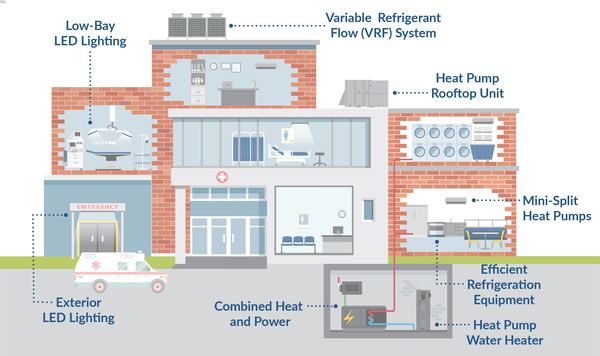Hospitals

Hospitals can reduce their energy consumption, minimize impact on the environment, and protect their bottom line by upgrading to high-efficiency equipment and systems. According to a U.S. Environmental Protection Agency (EPA) study, every dollar a non-profit hospital saves through better energy performance is equivalent to generating up to $20 in revenues.
*Source: U.S. Environmental Protection Agency, energystar.gov/ia/partners/spp_res/Custom_Healthcare.pdf
Solutions
Heating, Ventilation, and Air Conditioning (HVAC)
- According to an Efficiency Maine study, HVAC systems account for an average 21% of electricity use in healthcare facilities. Hospitals can save money and increase equipment reliability by making energy-efficient choices when installing or replacing heating, cooling or ventilation (HVAC) equipment. Efficiency Maine offers incentives for:
HVAC Solutions
- Ductless Heat Pumps
- Variable Refrigerant Flow (VRF) Systems
- Heat Pump Rooftop Units (RTUs)
- Energy Recovery Ventilators (ERVs)
- And more
Click here to learn more.
Lighting
- Lighting system upgrades can reduce lighting costs and improve light quality for a more comfortable environment. High-efficiency LEDs are easily integrated with controls. Efficiency Maine offers incentives for:
Lighting Solutions
- LED Retrofit Kits
- New LED Fixtures
- Exterior Lighting
- And more
Click here to learn more.
Refrigeration
- Refrigerators and freezers are an important part of every commercial kitchen. Efficiency Maine provides incentives for refrigeration controls and the purchase of new energy-efficient equipment and retrofits for existing equipment.
Refrigeration Solutions
- Scroll Compressors
- High-Efficiency Evaporator Fan Motors
- Strip Curtain for Cooler or Freezer
- Door Heater Controls for Cooler or Freezer
- Evaporator Fan Motor Controls
- Floating Head Pressure Controls
- And more
Click here to learn more.
Commercial Kitchen Ventilation
- Demand Control Kitchen Ventilation systems regulate fan speed depending on real-time demand rather than functioning at full capacity all day. Demand control ventilation systems can reduce energy required by ventilation as much as 65%.
Click here to learn more.
Plug Loads
Administrative offices, examination rooms and reception areas use office equipment and medical equipment that can have a big electrical draw, even when not in use. Consider purchasing ENERGY STAR certified equipment when next updating office equipment, which is 30-75% more efficient than standard equipment. There are also resources to help you identify energy demands of medical equipment; some medical equipment may also be able to be powered down during off-hours. To learn more about ways to manage electricity demand of medical equipment, click here for a National Renewable Energy Lab Report. And to learn more on how to reduce electricity usage, visit the Energy Star website.
Custom Solutions
Don’t see your energy solution listed above? Efficiency Maine also offers incentives for customized, site-specific energy solutions, including integrated HVAC controls, building envelope upgrades, combined heat and power installations, and more. Click here for more information on the Custom Program.
Get Started
 Ready to upgrade your facility with high-efficiency equipment and appliances? Work with an Efficiency Maine Qualified Partner in order to be eligible for these incentives. See our Qualified Partner video for more information on this process.
Ready to upgrade your facility with high-efficiency equipment and appliances? Work with an Efficiency Maine Qualified Partner in order to be eligible for these incentives. See our Qualified Partner video for more information on this process.
Click here to find a Qualified Partner working near you. If you work with a contractor that is not yet a Qualified Partner, urge your contractor to find out more information here. As part of the project approval process, you will accept the C&I Prescriptive Program’s Terms and Conditions. If you’re interested in becoming a Qualified Partner, click here to see our Become A Qualified Partner page.
If you’re interested in getting started with an energy efficiency project in your business but don’t know where to start, you can sign-up for a virtual customer consultation here.
Additional Information and Resources
- Warehouse Low-Cost Operations and Maintenance Checklist from Energy St
